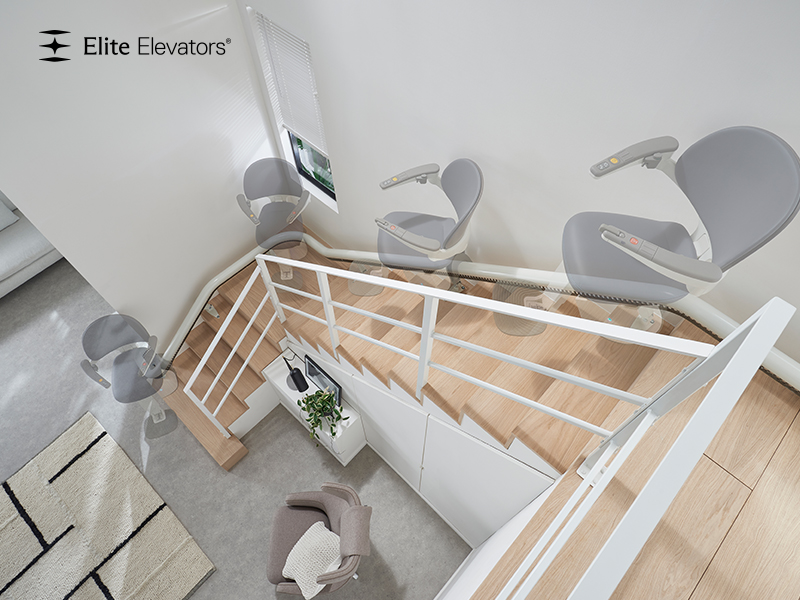Choosing the right stair lift is a crucial decision for enhancing mobility and safety within your home. With two primary options available—straight and curved stair lifts—understanding their differences can help you determine which is the best fit for your needs. This guide explores the features, advantages, and considerations of each type to assist you in making an informed choice.
Understanding Stair Lifts
What Are Stair Lifts?
A stair lift is a motorized device designed to transport individuals up and down stairs safely. It consists of a chair or platform that moves along a rail installed on the staircase. Stair lifts are ideal for individuals with mobility challenges, offering convenience and independence.
Stair lifts are motorized devices designed to assist individuals in navigating stairs safely and effortlessly. They are particularly beneficial for people with mobility challenges, such as seniors, individuals with disabilities, or those recovering from injuries, enabling them to move between floors with ease and independence.
A stair lift typically consists of a chair or development platform mounted on a rail system that runs along the staircase. The user sits on the chair, secures themselves with a seatbelt, and operates the lift using simple controls, such as a joystick or remote. Stair lifts are powered by electricity or rechargeable batteries, ensuring reliable operation even during power outages.
There are two primary types of stair lifts: straight and curved. Straight stair lifts are designed for linear staircases without bends or landings and are often more affordable and quicker to install. In contrast, curved stair lifts are custom-made to fit staircases with curves, turns, or multiple landings, offering a seamless solution for complex designs.
Modern stair lifts come with a variety of features to enhance safety and comfort. These include swivel seats for easy entry and exit, safety sensors to detect obstacles, foldable designs to save space, and adjustable settings to accommodate different user needs.
The Two Main Types
- Straight Stair Lifts: Designed for linear staircases with no curves, bends, or landings.
- Curved Stair Lifts: Custom-built to fit staircases with curves, turns, or multiple landings.
Straight Stair Lifts
Features of Straight Stair Lifts
- Simplicity: Built for staircases with a straight design.
- Ease of Installation: Typically quicker and less complicated to install.
- Cost-Effective: More affordable than curved models due to standardized design.
- Pre-Made Tracks: Come with ready-made, straight tracks that do not require customization.
Pros of Straight Stair Lifts
- Budget-Friendly: A great option for those with limited budgets.
- Quick Turnaround: Faster installation process.
- Low Maintenance: Simpler design requires less upkeep.
Cons of Straight Stair Lifts
- Limited Application: Not suitable for staircases with curves or intermediate landings.
- Less Flexible: Cannot adapt to complex staircase designs.
Curved Stair Lifts
Features of Curved Stair Lifts
- Custom Design: Tailored to match the exact layout of your staircase.
- Versatility: Can accommodate curves, corners, and multiple landings.
- Enhanced Aesthetics: Provides a seamless and elegant fit for your staircase.
Pros of Curved Stair Lifts
- Custom Fit: Perfect solution for unique or complex staircases.
- Smooth Ride: Ensures continuous travel without needing to transfer between lifts.
- High Resale Value: Maintains value due to its tailored design.
Cons of Curved Stair Lifts
- Higher Cost: More expensive due to customization.
- Longer Lead Time: Requires precise measurements and manufacturing, leading to longer installation times.
- Complex Maintenance: Repairs and servicing may take longer.
Key Factors to Consider
1. Staircase Design
- Straight Staircase: A straight stair lift is the obvious choice.
- Curved or Multi-Landing Staircase: Opt for a curved stair lift for a perfect fit.
2. Budget
- Straight stair lifts are generally more affordable, making them ideal for those on a tight budget.
- Curved stair lifts, while costlier, provide unparalleled customization and functionality for complex staircases.
3. Timeframe
- If you need a quick solution, straight stair lifts are faster to install.
- Curved stair lifts require more time due to the custom manufacturing process.
4. User Needs
- Consider the user’s mobility requirements and preferences. For instance, curved lifts are better for users who may find transferring between multiple lifts challenging.
5. Aesthetic Preferences
- Curved stair lifts offer a more seamless and integrated look, especially for unique staircase designs.
Installation and Maintenance
Installation Process
- Straight Stair Lifts: Typically installed within a few hours, as they use pre-made tracks.
- Curved Stair Lifts: Installation takes longer due to the need for custom tracks and precise adjustments.
Maintenance Tips
- Regularly clean the tracks and chair.
- Schedule professional servicing annually.
- Address any mechanical issues promptly to ensure safety and longevity.
Comparing Costs
| Feature | Straight Stair Lifts | Curved Stair Lifts |
|---|---|---|
| Price Range | $2,000 – $5,000 | $8,000 – $15,000+ |
| Installation Time | 1-2 days | 2-4 weeks (including customization) |
| Suitability | Straight staircases | Complex, multi-landing staircases |
Conclusion
Choosing between a straight and curved stair lift depends on your specific needs, staircase design, and budget. If your staircase is simple and linear, a straight stair lift is an efficient and economical choice. However, for more complex staircases, investing in a curved stair lift ensures a tailored fit and enhanced usability.
Consulting with a professional stair lift provider can help you evaluate your options and make the best decision for your home and mobility needs. With the right stair lift, navigating your home can become safer, easier, and more convenient.









